|
November 1949 Radio-Electronics
 [Table of Contents] [Table of Contents]
Wax nostalgic about and learn from the history of early electronics.
See articles from Radio-Electronics,
published 1930-1988. All copyrights hereby acknowledged.
|
The virtues and evils
of the plethora types of television antennas was the subject of many magazine articles
back in the era preceding cable, Internet, and satellite program delivery methods.
Over-the-air broadcasts, while available free of cost to recipients, were often
fraught with signal and therefore picture and audio degradations due to signal blockage,
reflection, and multipath issues. How people dealt with the problems was also the
theme of many TV-related comics which also appeared in those magazines. Serious
efforts were made by engineers and homeowners to remedy those problems through a
combination of antenna design, mounting, amplification, cabling, and other methods.
Of course there were also the crazy "solutions" which involved tin foil over, between,
and around VHF rabbit ears and/or UHF loops. I must admit
to having also resorted to extreme measures in desperate attempts to pull in a television
program.
Indoor and Built-In Antennas - Their Strong and Weak Points
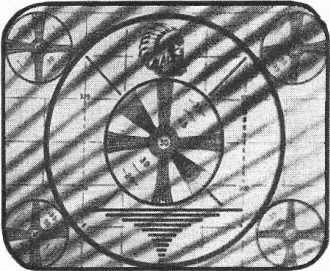
Fig. 1 - Interference from another set.
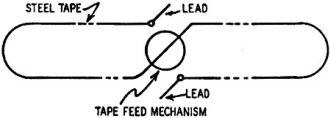
Fig. 2 - Slide-Rule is a folded dipole.
The indoor TV antenna yields only a compromise performance.
By Ira Kamen
John Stuart Mill said, "In times of crisis we must avoid both ignorant change
and ignorant opposition to change." This statement is wise counsel today both to
those selling and installing television receivers and to landlords of multiple dwellings.
The urban television dealer has not been able to realize full sales possibilities
because many building owners have refused to permit tenants to erect rooftop antennas.
Often, to make his sale, the dealer has installed in apartments TV receivers with
indoor antennas, the poor performance of which increased the tenant's resentment
against his landlord.
The latter is often justified in refusing his permission, or, as shown in the
photo, the roof becomes cluttered with a maze of disfiguring antenna rods, and the
landlord becomes liable for public, personal, and property damage.
In addition, random installations of rooftop antennas may result in penalties
for violation of local fire, building, and electrical ordinances. There are two
main reasons why so many buildings have roofs like the one in the photograph: either
the landlord did not want to offend tenants, or he used the permission as a way
of persuading them to agree to a rent increase. Some landlords are neither cringing
nor greedy, but allow the antennas so that tenants can enjoy television, feeling
that the appearance of the roof - never exactly artistic in any case, with clotheslines,
water towers, and so on - and the rather remote possibility of damage are subordinate
to peaceful relations between landlord and tenant.
On all rooftops overloaded with antennas interference between television receivers
may be so bad that on many evenings only two or three of a possible six or seven
channels can be used by most tenants. All other channels show r.f. interference
as pictured in Fig. 1. The Oscillator Interference Chart shows that when a television
receiver is tuned to channel 2, 3, 7, 8 or 9, its oscillator radiates interference
on either channel 5, 6, 11, 12, or 13.
The final solution
The permanent solution to the multiple-dwelling problem is a vacuum-tube-type
master antenna system such as approved by the engineering committee of Television
Broadcasters Association and conforming to RMA specifications. To date, two systems
have been tested and approved, one made by RCA and the other by the Intra-Video
Corp. of America. Both these systems suppress oscillator radiation enough to prevent
its marring the pictures of other RMA standard receivers connected to the system.
Any type of TV receiver may be connected to the system. Neither system is in common
use.
Many a dealer is temporarily convinced (against his better judgment) that this
or that indoor antenna is the answer, for he knows that a successful indoor antenna
would mean greatly increased sales.
Installation companies guaranteeing in the original contract reception for stations
not yet on the air should beware of the indoor antenna even though it may operate
satisfactorily for channels now in use. Nearly every indoor installation is a costly,
time-consuming experiment, and the set user is almost never fully satisfied. There
are call-backs and a resultant financial loss every time a new station goes on the
air.
There is no such thing as a high-gain indoor antenna. Even an adjustable unit
barely approaches the performance of a simple outdoor dipole on the channel to which
it is adjusted. Careful comparative tests should be made on all new "sensational"
indoor antennas before embarking on a wholesale indoor-antenna program.
The indoor antenna is not practical as a final solution to the problem. TV signals
do not pass readily through steel structures and are attenuated by the materials
of which houses are built. Such antennas are always a nuisance, whether installed
under a rug, in a closet, on a table or simply on top of the receiver.
Indoor antennas usable
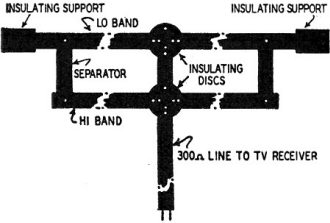
Fig. 3 - Under-rug unit of ribbon line.
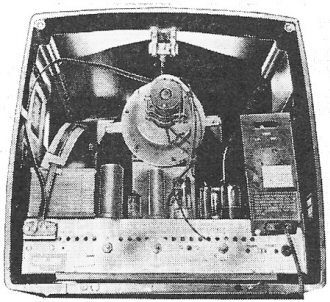
Fig. 4 - Philco's built-in TV antenna.
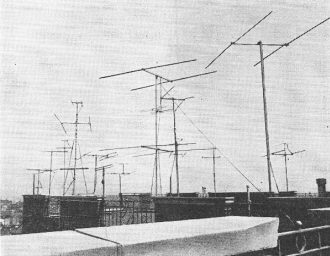
Forest of antennas on apartment roof. Close proximity can cause
interference.
There are, however, many locations where indoor antennas can provide a satisfactory
compromise signal from most stations. The set owner must, however, overlook faults.
There is a reduced signal-to-noise ratio and contrast will depend not only on the
control, but on the positions of people and furniture in the room. With an "under-the-rug"
antenna, every time someone walks across the room the contrast changes.
The signal quality varies, too, with the season. Window screens and foliage affect
it during the summer, and during the winter, when the indoor antenna is picking
up a reflected signal from a building or a mountain, ice formation on those surfaces
may change picture quality and strength.
The Tele-Tone has rotatable V antenna.
The only time, in fact, when an indoor antenna works excellently is when it is
near a window from which it is possible to see the TV transmitting antenna.
Practical Indoor Antennas
For portable receivers, the indoor antenna is of course a must. The most practical
is the rotating adjustable V which can be turned and the length of which can be
adjusted. A typical one is used with the Tele-tone receiver in the photo. While
the V antenna was originally a means of minimizing the space needed for a dipole,
it definitely has an important advantage. Although TV transmitters send out horizontally
polarized waves, reflections produce a signal which has a different angle of polarization
from the original. By setting the V at the correct angle the two (direct and reflected)
signals of different polarization can be combined in phase and the signal increased.
Many receivers with only average sensitivity may be installed with an indoor
antenna yielding a weak signal, if a booster amplifier with a minimum gain of 20
db is connected between antenna and receiver. The booster should not oscillate and
should pass the full 6-mc bandwidth required for good reception. Many boosters have
such narrow bandwidths that they do not permit the TV, receiver to "track" on picture
and sound simultaneously. Many oscillate on some channels, mismatch the antenna
input, and are unstable.
Another practical indoor antenna is the Radio Craftsmen slide-rule. The length
of a folded dipole is adjusted like a steel measuring tape. While the length of
this antenna is adjustable, it cannot offer a perfect 300-ohm match except at one
adjustment (if at all) for the distance between elements cannot be varied. This
distance should vary from 0.54 to 0.145 inch for optimum results from channels 2
to 13. This antenna's shape is not like that of a conventional folded dipole, either,
as illustrated in Fig. 2.
Fig. 3 shows a typical under-the-rug antenna with high- and low-band folded dipoles
made of ribbon line. Occasionally three or four of these must be installed and a
switch provided at the receiver to select the one adjusted for the desired station.
In other installations pairs of dipole rods are installed in different sections
of an apartment and co-axial cables circuited to a co-ax switch at the receiver.
While several indoor antennas and a switch may provide satisfactory reception, it
is a rare customer who will accept and pay for such an installation.
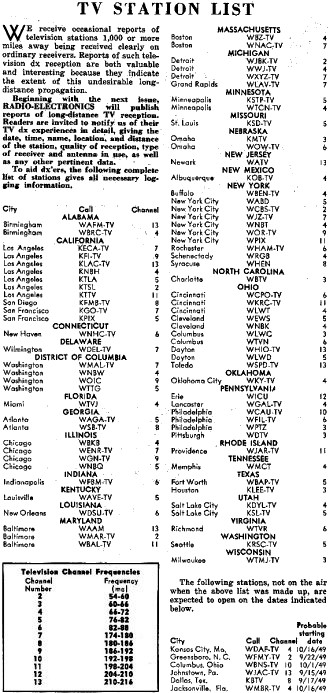 It is conceded that a built-in TV in-door
antenna (Fig. 4) would be a great stride toward full realization of customer acceptance
of television. Capitalizing on this fact, several manufacturers have made judiciously
worded claims to having solved this problem. However, as one of these manufacturers
stated: "gold is where you find it." Indoor antennas - whether built-in or portable
- will pick up television signals only if they are present in the vicinity of the
indoor antenna, and the quality of the reception cannot be improved over the quality
of the signals received. It is conceded that a built-in TV in-door
antenna (Fig. 4) would be a great stride toward full realization of customer acceptance
of television. Capitalizing on this fact, several manufacturers have made judiciously
worded claims to having solved this problem. However, as one of these manufacturers
stated: "gold is where you find it." Indoor antennas - whether built-in or portable
- will pick up television signals only if they are present in the vicinity of the
indoor antenna, and the quality of the reception cannot be improved over the quality
of the signals received.
Actual tests of built-in antennas indicate early enthusiastic customer reaction
in some areas (Brooklyn, Queens, Kings, and Westchester County in New York) where
strong TV signals from a majority of nearby TV stations have an unobstructed path
to the indoor antenna from one general direction. As expected, in Manhattan, dealer
and multiple-dwelling reception with built-in antennas has been generally poor.
The following disadvantages have been noted by TV dealers:
On stations where signals are weak, the tuning adjustments become complex to
the layman. The customer must keep his hands off the top of the cabinet as he tunes
the antenna or else he affects the tuning. Metal trays or other large appurtenances
cannot be placed on top of the cabinet by the customer.
In first-floor dealer establishments the built-in antenna will work on only one
or two stations in one or two locations in the store, which reduces the flexibility
of the dealer's sales operation. In many cases the dealer's service-man must sell
the customer on accepting the reception of the built-in antenna or rapidly install
an outdoor antenna before the customer rejects the merchandise.
The service technician who has the responsibility of asking the "lady of the
house" to relocate the TV receiver with built-in antenna in another section of the
room or a different room where the TV receiver will pick up more channels, must
have an outstanding sales personality. Many amusing situations have arisen where
the receivers with built-in antennas work best in the middle of the living room,
in front of a window, and in other locations which the customer usually rejects.
The idea of installing a TV antenna on the power line cord or as a permanent
unit in the rear of a console TV set as though it were a built-in radio antenna
is impractical. Several manufacturers have spent considerable money and time to
prove it. Certainly for apartment-house installations, it is; impossible except
when the TV receiver is against a favorably placed wall or in front of a window.
The increasing number of TV stations will start the indoor antenna on the road
out except for portable receivers and for those people willing to accept compromise
reception.
The plight of viewers living in multiple dwellings will be finally relieved when
the landlord again faces a buyers' market and realizes that he must give his tenants
television outlets just as he provides heating, plumbing, ventilation, and other
fundamental services.
Many of our readers will not agree with Mr. Kamen on this controversial subject.
For a different view, see
Noll and Mandl
in last month's issue (page 29) - Editor.
Posted November 24, 2021
|

































